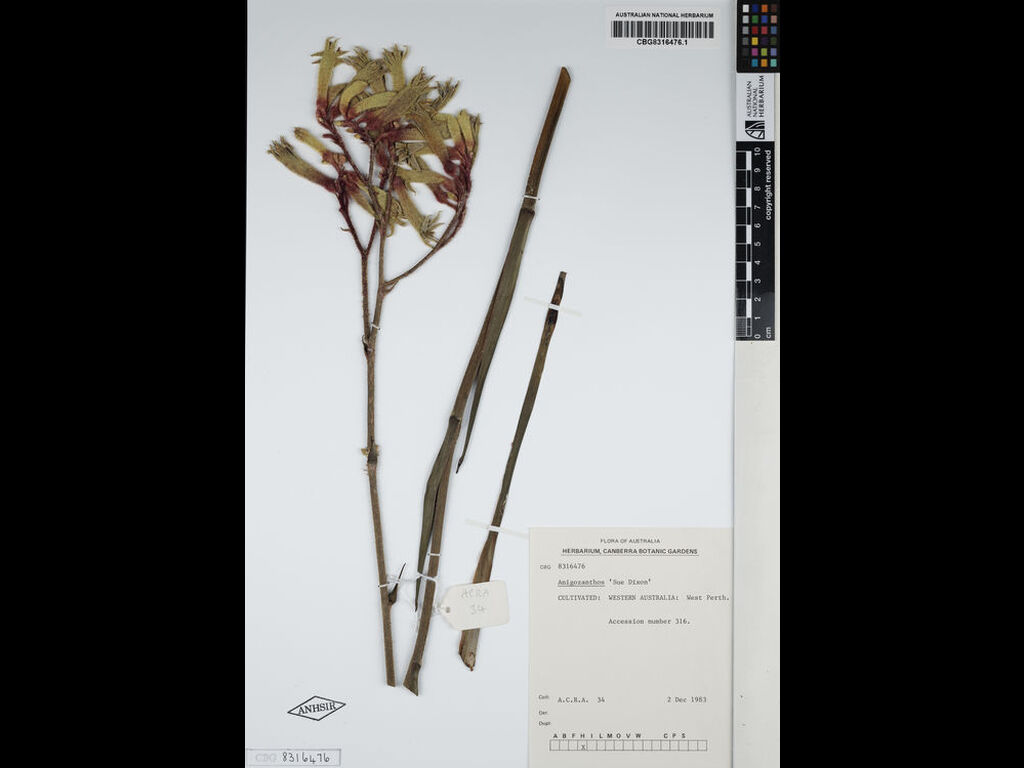Anigozanthos 'Sue Dixon'
- File Number
- 316
- ACRA Field Book Number
- 34
- Registration Date
- 06/10/1990
- Application Received
- 01/12/1983
- Family
- Haemodoraceae
- Cultivar Name
- Anigozanthos 'Sue Dixon'
- Origin
- Anigozanthos 'Sue Dixon' is a hybrid cross between (A. manglesii x A. rufus) x A. flavidus. The cross was performed by Mr K R Oliver. It is named after the wife of a former employee of the Perth Zoo, Mr R Dixon. The cultivar was first received by the Authority in December 1983. Registration applied for by the Perth Zoo Social Club, Perth, Western Australia.
- Characteristics
- The flowering stems reach 75cm tall, slightly woolly towards the base and becoming more dense towards the top. Flowers are in a simple terminal raceme, on pedicels up to 12mm long. The dense plumose wool on the flowers is red on the ovary and pedicel becoming more yellow immediately above. Perianth tube to ca. 4.5 cm long, scabrous inside, hairs becoming more linear towards the base, with stellate tips immediately above the ovary. Lobes to 1.3cm long, plumose woolly inside, the hairs sometime purple. Anthers linear, slightly longer than filaments, the connective tipped with a small gland-like appendage. Ovules ca. 6 per locule. The flowering season is from October to November. Diagnosis: This cultivar differs from A. manglesii in having shorter corolla lobes which are not as reflexed as those in A. manglesii. The corolla tube is round at the end (flat in A. manglesii and the greenish yellow anthers (green in A. manglesii) form a part circle (flat in A. manglesii). The leaves are almost evergreen and similar in colour to A. flavidus. The cultivar differs from A. rufus in having a broader and longer corolla tube and bigger lobes. There is less branching on the flower stem and fewer flowers on the branches. The colour of the flower is two-toned ie changes at the base of the corolla tube (in A. rufus it is the same right through to the flower stem). This differs from A. flavidus in having a shorter flower stem and less branching on the stem. The corolla tube is broader and slightly longer than in A. flavidus, and the corolla lobes are reflexed right back. Anthers are greenish yellow (orange in A. flavidus) and bigger with longer filaments.
- Cultivation
- The cultivar first came into cultivation in 1972. It must be propagated by vegetative means to preserve the cultivar form.
- Publication
- Australian Plant Cultivars. Australian Plants 17(134)
- Colour Coding
- RHS COLOUR CHART 1966perianth tube:overall colour close to Red Group 45A grading toYellow-Green Group 154A
- Propagation
- Division or tissue culture
- Applicant Name
- Perth Zoo Social Club
- Uses
- As part of a mass planting or mixed in a shrubbery, or as a spectacular feature plant. Attracts nectar feeding birds.
- Availability
- Unknown
- ANBG Accession Numbers
- ACC316, ACRA34, CBG8316476
- NSL ID
- -

